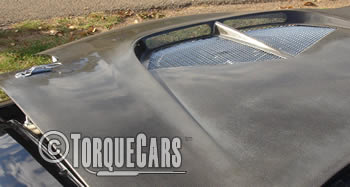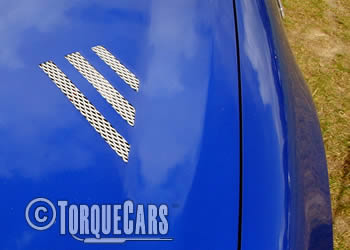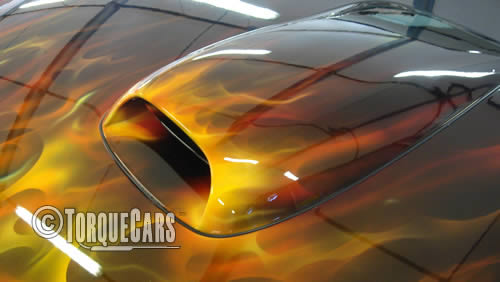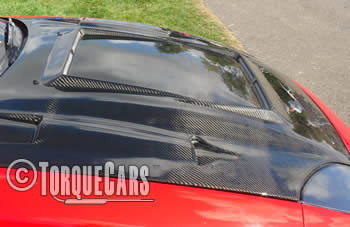Bonnet vents.
"Performance. Bonnet vents."
 Performance gains are possible with the addition of bonnet vents.
Performance gains are possible with the addition of bonnet vents.
Warm air really does kill performance. This is due to the air intake temperatures being hot and air at high temperatures carries less oxygen.
When driving an engine hard the under bonnet temperatures quickly build up and the engine has no choice but to suck this air in reducing your power.
It takes about 2 miles for cars engine bay to reach ambient temperatures in day to day driving conditions. In stop start traffic the engine bay may never reach ambient temperatures at all.
In supercharged engines and turbo charged engines the intake air is further heated by the compression process. This heated intake air is pulled through an intercooler which helps to reduce the air charge temperatures but for this to work effectively the intercooler needs cold air flowing through it. An intercooler is simply a heat exchanger and eventually the intercooler housing will warm up (called heat soak)
Due to the large radiator placement at the front of the engine it is quite difficult to get cold air running though the intercooler and one way round this problem is to have a top mounted intercooler with a vent cut in the bonnet. Some standard cars have this arrangement and a scoop to feed the cold air through the intercooler (the Subaru Impreza for example).
Bonnet vent styles.
 Some manufacturers have got round this by putting the intercooler on the top of the engine and feed cold air through a vent in the bonnet. Some TorqueCars members have cut vents into their bonnets as they see the performance gains on offer without being interested in the styling benefits.
Some manufacturers have got round this by putting the intercooler on the top of the engine and feed cold air through a vent in the bonnet. Some TorqueCars members have cut vents into their bonnets as they see the performance gains on offer without being interested in the styling benefits.
Bonnet vents are also popular in motor sport and the Mitsubishi Evo bonnet has conspicuous vents across it and the Subaru Impreza has a top mounted intercooler with a bonnet scoop.
The downside of having a top mounted intercooler is when the car is stationary it is actually not getting a flow of air through it but when you think about it if a car is stationary the last thing you want is performance.
Ideally the vents should be located
1) Near the air intake filter so cold air from outside can be pulled in. A little additional ducting will help channel more cold air to the filter and stop the warm under bonnet temperatures from entering. (Avoid putting the filter in an enclosed box with cold air feeds as this will alter the induction length see our cold air induction article for details.)
2) Paired with a scoop should be placed directly over the intercooler the cold air will then enter the engine bay cooling the surrounding air and helping reduce intake temperatures.
3) Much heat comes from the exhaust part of the engine so a vent a few inches behind that area will do much to reduce the under bonnet temperature. If the vent is directly above the radiator the cooling effect will be reduced.

Vents can be cut into the bonnet but are typically covered with a mesh of some description partly to improve appearance and partly to protect engine components from damage should a stray stone fly in its direction. Some carbon fibre bonnets have moulded vents in them and these give the best finish.
Plastic and fibreglass panels can also augment a cutout hole in a metal bonnet or hood and keep the pleasing lines and add ridges to assist airflow but it is hard to get a smooth blended finish on these stick on vents. For the time and hassle involved you are usually better off going with a pre cut bonnet and fitting that instead of the standard one.

You needn't just have vents in the bonnet you can also place them in the wing in a BMW style shark gill vent. A good vent design on a bonnet makes provision for both cold air to get in and a route for the hot air to exit.
A raised lip can create turbulence which will help to keep the air flowing through the engine bay. Always site the cold air intake directly below a vent as it will create a vacuum or low pressure region around it and also site a vent a few inches back from the radiator and exhaust outlet.
Always add mesh behind the vent as a stone flying into the engine at high velocity can cause major problems (it can also look cool).
If you are cutting a vent into your cars bodywork we suggest removing the part and cutting from the rear. This allows you to make a neater job on the exterior and also allows you to see the supports and strengthening beams which should not be cut.
If you liked this page please share it with your friends, drop a link to it in your favourite forum or use the bookmarking options to save it to your social media profile.
Check out TorqueCars new YouTube channel, and see their awesome new content...
Feedback
Please use our forums if you wish to ask a tuning question, and please note we do not sell parts or services, we are just an online magazine.
Help us improve, leave a suggestion or tip
